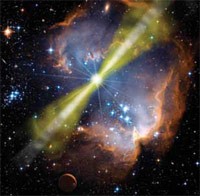Surprising Ingredients of Early Galaxies

By Lisa Paitz Spindler
Gamma-ray bursts (GRBs) are flashes of electromagnetic radiation observed happening in very distant galaxies. Usually lasting about 30 seconds, these supernovae provide scientists with a glimpse of space millions of years ago. A team of astronomers led by the Max Planck Institute for Extraterrestrial Physics has used a particularly brilliant gamma-ray burst, called GRB 090323, as a probe to study the make-up of faraway galaxies 12 billion years ago, only 1.7 billion years after the Big Bang.
The probe revealed two young galaxies merging, the GRB passing through another neighboring galaxy enabling astronomers to observe both. More importantly, though, scientists also observed higher amounts of heavier metal elements than expected. The amount of heavier chemicals present in galaxies is often used as a measure of its age: the older the galaxy, the more chemical enrichment.
"When we studied the light from this gamma-ray burst we didn't know what we might find. It was a surprise that the cool gas in these two galaxies in the early Universe proved to have such an unexpected chemical make-up," explained Sandra Savaglio from the Max-Planck Institute for Extraterrestrial Physics and lead author on the paper describing the phenomenon. "These galaxies have more heavy elements than have ever been seen in a galaxy so early in the evolution of the Universe. We didn't expect the Universe to be so mature, so chemically evolved, so early on."
Window to a New World
Because of dense gas obscuring the area and absorbing some wavelengths of light, the gamma-ray burst lit up an area of space scientists might not have been able to observe otherwise. For such heavy elements to be present in young galaxies, the pair must be forming new stars very quickly. "We were very lucky to observe GRB 090323 when it was still sufficiently bright, so that it was possible to obtain spectacularly detailed observations… Gamma-ray bursts only stay bright for a very short time and getting good quality data is very hard," said Savaglio.
Classroom Discussion
- One of the telescopes used to observe this GRB was the Very Large Telescope (VLT) in northern Chile. What are some other telescopes that astronomers use to observe galactic phenomena?
- Gamma rays are one type of light wavelength. What are some other wavelengths of light?
